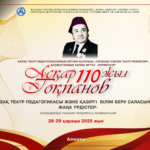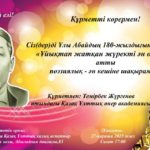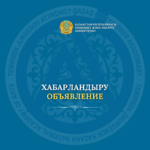Republican State Institution T. K. Zhurgenov Kazakh National Academy of Arts of the Ministry of Culture and Sports of the Republic of Kazakhstan
International scientific-practical conference «Youth Creative Associations in the Creative Space: Strategies, Educational Environment, Implementation Mechanisms»

Information Letter
Dear friends and colleagues!
T. K. Zhurgenov Kazakh National Academy of Arts (Almaty, Kazakhstan) plans to hold an international scientific and practical conference on «Youth Creative Associations in the Creative Space: Strategies, Educational Environment, Implementation Mechanisms» dedicated to the 30th anniversary of the Independence of the Republic of Kazakhstan.
Date and Time: 26.11.2021, 2:00 p.m.
Place: T. K. Zhurgenov Kazakh National Academy of Arts (offline and online)
Organisers: Academic-Editorial Department and Department of Art Management and Producing, T. K. Zhurgenov Kazakh National Academy of Arts
Partners: Impact Hub Almaty, Goldsmith University of London
Organising Committee Address: 050000, Republic of Kazakhstan, Almaty, 127, Panfilov Street
Telephone: +7 (727) 272-04-99
Email: sed_kaznaa@mail.ru
Official Website: https://kaznai.kz/
Instagram: @zhurgenov.science
It is planned to publish a collection of conference abstracts. The articles that will pass the selection of the commission are supposed to be published in the thematic issue of the Central Asian Journal for Art Studies (indexed in the Committee for Control in the Sphere of Education and Science of the Ministry of Education and Science of the Republic of Kazakhstan, EBSCO, Kazakhstan Citation Base, NCSTE, CyberLeninka, Publons):http://cajas.kz/
Conference Languages: Kazakh, Russian, English
Time Limit for Presentations with Reports: no more than 7 minutes (+ 5 minutes of discussion).
GOAL: To determine the special significance of the young generation in developing the culture as a branch of the modern national economy by holding a scientific forum that brings together the opinions of theorists and practitioners of creative industries.
TASKS:
- Collect up-to-date information on the state of the art market in Kazakhstan;
- Clarify the state of youth participation in creative industries;
- Identify problem areas of creative industries and outline solutions;
- Unite the efforts of scientists, entrepreneurs, teachers and government agencies in the field of creative industries;
- Outline a roadmap for the development of creative industries in Kazakhstan.
TOPICS FOR DISCUSSION:
- History and prospects for the development of creative industries in the world: regional features and geopolitical context;
- Creative industry as a resource of the future: the relationship of educational programs and employers in the field of culture and art;
- The role of large, medium and small businesses in developing creative industries and the regulatory framework.
The following organisations are expected to participate in the conference:
- Department of Creative Industries of Almaty
- National «Atameken» Chamber of Entrepreneurs
- The Kazakhstan Craftsmen’s Union
- Kazakhstan National Federation of UNESCO Clubs
- Kurmangazy Kazakh National Conservatory
- Turan University
- Kazakh National University of Arts
- Kazakh Leading Academy of Architecture and Civil Engineering
- The Uzbekistan State Institute of Arts and Culture
- Kyrgyz State University of Culture and Arts
- M. Tursunzade Tajik State Institute of Arts
- Tselinny Centre of Contemporary Culture (Almaty)
- ARTiSHOK Theatre (Almaty)
- Eurasian Cultural Alliance (Almaty)
- Youth Association MATA (Almaty)
- School of Art Research Methodology (Bishkek)
- ССA Lab (Tashkent)
Invited to participate in the conference are scientists, masters students, undergraduates and teachers conducting scientific research aimed at studying the specifics of the operation of economic laws in the socio-cultural sphere, financing, commercialisation of human activity in the field of culture, management of art industry enterprises, modelling and assessing their business processes in conditions of the modern market economy. Also invited are organisations and foundations whose field of activity is directly related to the creative industries – the production of products and services in the field of art, culture, education and information technology – graduates of creative universities, practitioners and representatives of the art industry enterprises with experience in managing economic relations in the field cultures who are ready to share their ideas for effective management.
Applications and abstracts are accepted until November 20, 2021 (inclusive). The full text of the article that has passed the selection in CAJAS is accepted until January 10, 2022 (inclusive) at sed_kaznaa@mail.ru with the obligatory subject line «CONFERENCE CI 2021».
Appendix 1. Application Form.
Application for participation in the international scientific and practical conference «Youth Creative Associations in the Creative Space: Strategies, Educational Environment, Implementation Mechanisms of T. K. Zhurgenov Kazakh National Academy of Arts
| Full Name (as in an identity card or passport) | |
| Place of Work/Place of Study (Full name of the institution without abbreviations) | |
| Position/Course and Department for Students | |
| Academic Degree, Academic Title, Honorary Title (if available) | |
| Contact Phone Numbers (WhatsApp, Telegram) | |
| Email Address | |
| Postal Address (with postal code) | |
| The Topic of the Report and/or Article (without quotation) | |
| Presentation of the Report (yes/no) |
Appendix 2. Requirements for Articles.
The editorial board accepts only original, previously unpublished scientific articles prepared per generally accepted scientific and ethical standards. The topic of an article should correspond to the conference’s topic, one of the main headings or sections.
ARTICLES DRAFTED WITHOUT CONSIDERATION OF THE FOLLOWING REQUIREMENTS ARE NOT ACCEPTED FOR PUBLICATION!
The editorial board of the journal must be provided with:
1. Application for participation in the conference with an abstract of the article
2. The original article in MS Word format (Example of the article’s title: Asylbekov Article).
REQUIRED TEXT PARAMETERS
Font: Times New Roman
Kegel: 14 pt
Line spacing: 1,0 (no spacing between paragraphs of the same style).
Article Size: 15000-25000 characters with spaces (excluding annotations, keywords, notes, list of sources).
All submitted articles are checked for plagiarism. The percentage of borrowing can be no more than 20%.
Text structure:
1. The UDC and MRSTI indexes that reveal the article’s thematic content (in the upper left corner in bold).
2. Information about the author/authors (centred in italics) – full name, academic degree, academic title, honorary title, position, place of work/study including the department (if any), ORCID, SPIN code, e-mail address. The text is provided in Kazakh, Russian and English.
Undergraduates, masters students, doctoral students and graduate students include all supervisor details: full name, academic degree, academic title, position, organisation. The text is provided in Kazakh, Russian and English.
3. Title of the article (in bold CAPITAL letters in the centre). The text is provided in Kazakh, Russian and English.
4. Abstract: a summary of the article according to the following structure: the relevance of the problematics and novelty, the main substantive aspects, research methods, results: at least 100 words. Placed with a space after the title of the article. Text alignment is justified. The text is provided in Kazakh, Russian and English.
5. Keywords for the content of the abstract and article (8-10 words). Placed after annotation. The main text alignment is justified. The text is provided in Kazakh, Russian and English.
6. It is desirable to split the article’s main text into subsections (introduction, literature review, main part, research results). The main text alignment is justified.
7. List of sources/literature. Text alignment is justified.
Initials in the text are typed through a NON-BREAKING SPACE with a surname (simultaneously pressing the «Ctrl» + «Shift» + «Space» keys). Example: T. K. Zhurgenov. Not allowed: T.K.Zhurgenov
The text uses quotation marks «…». If there are inner and outer quotes, then the outer ones are «herringbones», the inner ones are «paws» — «… “…”».
The text uses an em dash (—), obtained by simultaneously pressing the keys «Ctrl» + «Alt» + «-« (on the numeric keypad), as well as a hyphen (-).
Lists and checklists do not use automatic numbering.
Infographics, including tables, diagrams, figures and formulas in the text, should be numbered; diagrams and tables should have titles placed above the diagram or table field, and each figure should have a caption.
The list of sources (from 7 to 15 titles) is drawn up in the form of back-text bibliographic references in accordance with the adopted GOST and is placed at the end of the article. The city of the publication is registered in full, including Moscow, St. Petersburg, etc.
Some examples:
Books:
Sats N. I. Children Сome to the Theater. – Moscow: Art, 1961. — p. 312.
Magazines, newspapers:
Smetova, A. A., Mukasheva, A. B. Formation and Development of Conductor-Choral Education in Kazakhstan // Bulletin of KazNU. «Pedagogical Sciences» Series. — 2015. — No. 1 (44). — pp. 4–10.
Collections of articles and conferences:
Marchenkova A., Marchenkov A. Artistic Image in Choreographic Art // Actual Problems of Pedagogy: Materials of the III International Scientific Conference. —Chita: Young Scientist, 2013. — pp. 25–32.
Electronic sources:
Podkorytova M. O. Behind the Scenes of Cirque Eloize. How the Show About Love is Created [Electronic source] // Official Website of the Online Publication Uralweb.ru / URL: http://www.uralweb.ru/pages/provereno/6462.html (Date of access: 19.04.17).
Sources are given in the order of mention/citation in the article. References to the list in the main text are given in square brackets [number of the source in the list, page] (for example, [8, pp. 10—15; 9, p. 128]).
If it is necessary to recite the source, the reference is given to the number of the first reference to the source. Duplicate and complex links are not used. The headings (and titles of the journals) in the second and subsequent references must not be replaced by their verbal equivalents «Ibid», etc.
When formatting the list of sources, the automatic numbering of the text editor is not used; the ordinal number is separated from the link text by a tab. The punctuation marks «dot» and «dash» separating the areas of the bibliographic description are replaced by a dot. All bibliographic references to electronic sources must indicate the date of access. It is preferable to refer to scientific, special or fiction literature in printed form.
When citing Internet sources, it is necessary to indicate as fully as possible the full name of the author (authors), the exact title of the work, the name of the source that published the described document, as well as an exact link to the original web page (and not to the main page of the site from which material taken), date of access, etc.
При цитировании интернет-ресурсов необходимо максимально полно,
Any mention of the names of scientists and researchers in the text of the article must be accompanied by references to their work.
Notes are formatted as footnotes. The footnote sign is placed immediately after the word/number/symbol/sentence to which the explanation is given. The file names in the list must correspond to the names/numbers of the provided photographic materials.
2) Illustrative materials
Submitted in electronic form as separate files through the electronic editing system as additional materials in TIFF/JPG formats with at least 300 dpi resolution simultaneously with the original article. It is not allowed to provide illustrations imported into Microsoft Word, as well as their photocopies.
Tables, charts, diagrams, and graphs are provided in a file in Microsoft Word or Microsoft Excel format, including source data, in which graphic materials can be edited.
Illustrative material and infographics must be adapted for high quality black and white printing.
The author provides figure captions (included in the file with the author’s text) for all images,
The authors of the articles are responsible for the content of the articles and the very fact of their publication. The editorial board does not always share the opinions of the authors and is not responsible for the unreliability of the published data. The editorial board does not bear any responsibility to the authors and/or third parties and organisations for possible damage caused by the article’s publication.






